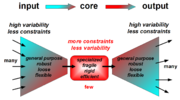.gif)
Bow tie (biology)
Encyclopedia
The term bow tie refers in science to a recent concept that tries to grasp the essence of some operational and functional structures observed in biological organisms and other kinds of complex
and self-organizing systems. In general, bow tie architectures refer to ordered and recurrent structures that underlie complex technological or biological networks, and that are capable of conferring them a balance among efficiency, robustness and evolvability. Bow ties seem to be capable of managing a wide range of inputs through a core (or knot) constituted by a limited number of elements. In such structures, inputs are conveyed into a sort of funnel, towards a "synthesis
" core
, where they can be duly organized, processed and managed by means of protocols http://en.wiktionary.org/wiki/protocol, and from where, in turn, a variety of outputs, or responses, is propagated.
 According to Csete and Doyle, bow ties are able to optimally organize fluxes of mass, energy, signals in an overall structure that forcedly deals with a highly fluctuating and "sloppy" environment. In a biological perspective, a bow tie manages a large fan in of stimuli (input), it accounts for a "compressed" core, and it expresses again a large fan out of possible phenotypes, metabolite
According to Csete and Doyle, bow ties are able to optimally organize fluxes of mass, energy, signals in an overall structure that forcedly deals with a highly fluctuating and "sloppy" environment. In a biological perspective, a bow tie manages a large fan in of stimuli (input), it accounts for a "compressed" core, and it expresses again a large fan out of possible phenotypes, metabolite
products, or -more generally- reusable modules. Bow tie architectures have been observed in the structural organization at different scales of living and evolving organisms (e.g. bacterial metabolism
network) as well as in technological and dynamical systems (e.g. the Internet). Bow ties seem to be able to mediate trade-offs among robustness
and efficiency, at the same time assuring to the system the capability to evolve.
Conversely, the same efficient architecture may be prone and vulnerable to fragilities due to specific changes, perturbations, and focused attacks directed against the core set of modules and protocols.
The bow tie architecture is one of several different structures and functioning principles that living matter employs to get self-organization
and efficient exploitment of available resources.
Complexity
In general usage, complexity tends to be used to characterize something with many parts in intricate arrangement. The study of these complex linkages is the main goal of complex systems theory. In science there are at this time a number of approaches to characterizing complexity, many of which are...
and self-organizing systems. In general, bow tie architectures refer to ordered and recurrent structures that underlie complex technological or biological networks, and that are capable of conferring them a balance among efficiency, robustness and evolvability. Bow ties seem to be capable of managing a wide range of inputs through a core (or knot) constituted by a limited number of elements. In such structures, inputs are conveyed into a sort of funnel, towards a "synthesis
Synthesis
In general, the noun synthesis refers to a combination of two or more entities that together form something new; alternately, it refers to the creating of something by artificial means...
" core
Core
- Science and Academics :* Core , in mathematics, an object in group theory* Core , in mathematics, a subset of the domain of a closable operator* Core , in mathematics, the homomorphically minimal subgraph of a graph...
, where they can be duly organized, processed and managed by means of protocols http://en.wiktionary.org/wiki/protocol, and from where, in turn, a variety of outputs, or responses, is propagated.

Metabolite
Metabolites are the intermediates and products of metabolism. The term metabolite is usually restricted to small molecules. A primary metabolite is directly involved in normal growth, development, and reproduction. Alcohol is an example of a primary metabolite produced in large-scale by industrial...
products, or -more generally- reusable modules. Bow tie architectures have been observed in the structural organization at different scales of living and evolving organisms (e.g. bacterial metabolism
Metabolism
Metabolism is the set of chemical reactions that happen in the cells of living organisms to sustain life. These processes allow organisms to grow and reproduce, maintain their structures, and respond to their environments. Metabolism is usually divided into two categories...
network) as well as in technological and dynamical systems (e.g. the Internet). Bow ties seem to be able to mediate trade-offs among robustness
Mutational robustness
Mutational robustness describes the extent to which an organism’s phenotype remains constant in spite of mutation. Natural selection can directly induce the evolution of mutational robustness only when mutation rates are high and population sizes are large...
and efficiency, at the same time assuring to the system the capability to evolve.
Conversely, the same efficient architecture may be prone and vulnerable to fragilities due to specific changes, perturbations, and focused attacks directed against the core set of modules and protocols.
The bow tie architecture is one of several different structures and functioning principles that living matter employs to get self-organization
Self-organization
Self-organization is the process where a structure or pattern appears in a system without a central authority or external element imposing it through planning...
and efficient exploitment of available resources.

